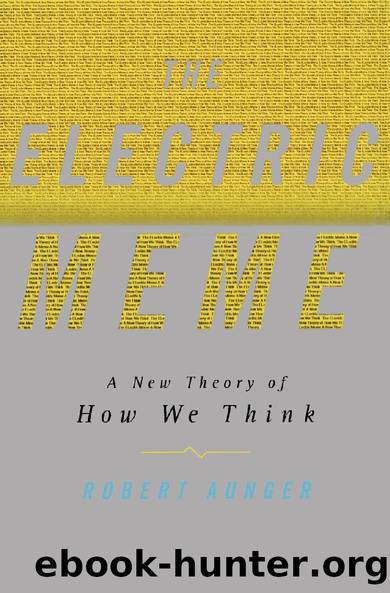The Electric Meme by Robert Aunger

Author:Robert Aunger
Language: eng
Format: epub
Publisher: Simon & Schuster
LA MÊME CHOSE
What makes two nodal states the “same” and therefore duplicates of one another? Being the same in evolutionary terms means being “identical by descent.” This technical phrase implies that two replicators share some physical features and have the same “parents.” So for two genes to be identical by descent, they must be copies that arose through replication from the same ancestral gene sequence. The copies of a particular gene in two siblings are identical by descent if they have been inherited from the same person, such as their paternal grandmother. By analogy, for two memes to be identical by descent, two nodes must have the same parental nodes and be similar in quality. What kind of quality is relevant?
Remember that our similarity criterion for memes requires only that they pass information through the neuronal network in the same way—this was the import of our Same Influence Rule, outlined earlier. This does not mean the nodes must be absolutely identical in terms of their physical layout but rather that, when stimulated, they perform in ways that have similar consequences to the larger network. This means, for neurons, that they must communicate roughly the same message to other nodes that themselves play equivalent roles in the network. The considerable redundancy in the brain gives memes ample opportunity to engage in parallel activities, despite their different locations.
Further, at the small scale at which memes are defined, there should be comparable connectivity matrices in different brains for small groups of neurons among the billions of connections made in each. Indeed there could be quite a few copies within a brain, allowing for movement of the memetic state to different locations or replication within a host to produce a (small) population of similar memes simultaneously. The combination of these two factors—the use of the Same Influence Rule to define similarity, and the fact that neuromemes are defined on a quite small scale—should guarantee that memetic states can be reproduced with some fidelity in different parts of the same brain (as well as between brains, as we shall see).
But what about the fact that two nodes releasing the same pattern of spikes at different places in the network seem to be saying something quite different by virtue of the fact that each drives the dynamics of the brain from a divergent angle? In this case, one state-A neuron in the primary visual cortex and a second state-A cell in some other region of cortex would not have an equivalent influence on brain activity. Doesn’t this negate the possibility of replication within a brain—according to the criteria we have set up—because no two neurons will have exactly the same effect on the larger network of which each is a part?
This is where it becomes important to remember the crucial distinction between local, or “value-added,” processing and global meaning, which reflects the cumulative decision-making by an information-processing stream. The node in the visual cortex from our example may be participating in exactly the same way in one decision-making circuit as the node somewhere else is doing in its own, independent circuit.
Download
This site does not store any files on its server. We only index and link to content provided by other sites. Please contact the content providers to delete copyright contents if any and email us, we'll remove relevant links or contents immediately.
The Art of Thinking Clearly by Rolf Dobelli(8841)
Mindhunter: Inside the FBI's Elite Serial Crime Unit by John E. Douglas & Mark Olshaker(7834)
Change Your Questions, Change Your Life by Marilee Adams(6641)
Nudge - Improving Decisions about Health, Wealth, and Happiness by Thaler Sunstein(6633)
Mastermind: How to Think Like Sherlock Holmes by Maria Konnikova(6235)
The Power of Now: A Guide to Spiritual Enlightenment by Eckhart Tolle(4755)
Men In Love by Nancy Friday(4322)
Factfulness: Ten Reasons We're Wrong About the World – and Why Things Are Better Than You Think by Hans Rosling(4021)
The Confidence Code by Katty Kay(3566)
Thinking in Bets by Annie Duke(3531)
Man and His Symbols by Carl Gustav Jung(3315)
Three Women by Lisa Taddeo(2920)
The Worm at the Core by Sheldon Solomon(2917)
Why Buddhism is True by Robert Wright(2826)
Liar's Poker by Michael Lewis(2811)
The Inner Life of Animals by Peter Wohlleben(2766)
Descartes' Error by Antonio Damasio(2731)
The Power of Mindful Learning by Ellen J. Langer(2710)
The Slow Fix: Solve Problems, Work Smarter, and Live Better In a World Addicted to Speed by Carl Honore(2574)
